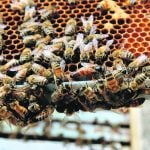Farmers thinking of tinkering with herbicide rates need to be aware that they’re also tinkering with safener rates in some products.
Doug Richardson, manager of research and development with Bayer CropScience in Calgary, said safeners are part of the process used by herbicides such as Puma Super and Horizon to control grass weeds in a grass crop.
“Wheat or barley have the ability to metabolize or break down the active ingredient better than the grass weeds can. However, they still need a little bit of help. The safeners help further metabolize the active ingredient, to assist the crops in breaking down the product even faster, so there is no injury,” Richardson said.
Read Also

VIDEO: Green Lightning and Nytro Ag win sustainability innovation award
Nytro Ag Corp and Green Lightning recieved an innovation award at Ag in Motion 2025 for the Green Lightning Nitrogen Machine, which converts atmospheric nitrogen into a plant-usable form.
“It comes down to the magical ratio. When these products are first developed, companies look at ratios of active ingredient to safener, to get optimum safety. Too much safener and you could start to reduce your grass control. These ratios of active to safener are researched, they find the right ratio and the end use product is created.”
Producers who cut rates risk injuring the crop and jeopardizing grassy weed control because of less active ingredient applied.
Richardson said the ratio and the registered rates are there for a reason. If farmers decide to shave rates, results will vary.
“I don’t think you’ll ever see the amount of injury on a crop that you’d see on a weed, but you’d probably see more chlorosis. You’ll see a colour change to the crop – it might lighten it up a bit. It could delay the crop or produce a bit of stunting,” he said.
“With Puma, it’s probably more of an issue with barley than there would be with wheat.”
Puma Super is the only Bayer product that contains a safener. Richardson said safeners are not considered an active ingredient.
“It’s another ingredient found in the formulation. Its purpose is to help the crop break down the active ingredient,” he said
“In the registration process, we conduct many trials, over many geographies and environmental conditions, over multiple years, which is a requirement of the PMRA (Pest Management Regulatory Agency). For the most consistent control, both weed control and crop safety, that’s why these rates have been selected.
“The rate registered offers the most consistent results. There is the risk, if a grower starts to reduce rates, that consistency could be lost.”
Puma Super has two rates on its label – half the rate required for wild oats will control green foxtail.
“Fenoxaprop is a fabulous product on green foxtail, but if you have any wild oats in your field and you try to go with just the green foxtail rate, I guarantee you’re not going to control your wild oats.”
Marian Stypa, head of regulatory and biological development with Syngenta in Guelph, Ont., said safener technology has been around for years and can be found in grass, corn and sugar cane herbicides.
“Traditionally the safeners are used in much lower ratios. The ratios can range from 1:1, up to 1:8 or 1:16, of safener to active ingredient,” Stypa said.
“When you cut rates, you don’t actually change the ratio, but there could be a rate where you’re going to lose the activity on the weed or there could be a point where you need a certain amount of safener to actually do anything. If you drop below that, then it may be a total flop. It’s very product specific. There’s no silver bullet and there isn’t one that does it all.”
Stypa said safeners are generally chemical compounds rather than micronutrients or enzymes.
“Usually what they do is interfere with the binding sites. In certain plants or with certain chemicals, they tie up the active ingredient, or slow down the release or uptake of it,” he said.
“There’s books written on the subject, looking at different classes of safeners, how they work with some chemistry and not others, or some plants and not others. It’s pretty complicated.”
Stypa said plant protection companies put a lot of research into their formulations to optimize the ratio and the compound used for safening. For some compounds, companies screen hundreds of potential safeners.
Products such as Bayer’s Puma and Syngenta’s Horizon have a built-in safener, while other products, such as Achieve, don’t have a safener.
“One of the things we look at is what broadleaf partner is going to be sprayed with this graminicide (grassy herbicide). Depending on what that partner is, there could be a better suited formulation – it could be water based, EC, WG or whatever,” he said.
“Then you’ve got adjuvants. For every product, there’s going to be a critical level. We’ve done work in the lab and if you drop the adjuvant below a certain level, the whole adjuvant benefit disappears. It goes from something to nothing. It’s very product specific.
“You’re taking an active ingredient, mixing that with emulsifiers that will allow it to mix better, then a carrier, a safener and maybe an adjuvant built into it. It gets pretty tricky and if you tinker with it, you can lose the optimization the companies have built into it. Things can change and not necessarily in a predictable fashion.”
In some cases, no amount of safener will guarantee a positive outcome. Eric Johnson, a weed biologist with Agriculture Canada at the research farm in Scott, Sask., has worked with Puma Super in canaryseed.
“The question I always keep getting from growers is, ‘what’s the safest rate,’ and the answer is ‘there is none.’ Some years I got injury and some years I didn’t, but no matter what rate I used, I’d get similar levels of injury,” he said.
“If you look at canaryseed, it’s somewhat related to green foxtail and it’s similar in its response to grassy herbicides as green foxtail. So it’s relatively easy to injure. It’s not as strong as a wheat or barley. It’s pretty difficult to take wild oats out of something like canaryseed.”
Johnson said crop injury can be reduced in some herbicides by cutting rates, but it won’t work if the herbicide relies on a safener and cutting rates means cutting the percentage of safener.
“We finally gave up, and the company did too, trying to register Puma Super because of that. We couldn’t safen it enough.”
Johnson said if safeners are going to safen the herbicide on the crop, the companies want the safeners to have the opposite response on the target weeds.
“You don’t want to safen it on the weeds, as well. It’s a fairly tricky science in that too much safener, you start reducing weed control as well,” he said.
“Another point to make is some broadleaf herbicides are somewhat antagonistic, so they actually safen grass herbicides, too. For example, a product like Everest, you’ll get less injury, especially with the older rates, when you’re tank mixing a broadleaf herbicide with it, particularly something that had a phenoxy in with it.”
Johnson said Puma Super’s tolerance was marginal when it was first looked at in wheat and barley, but the company has done a good job with the safener, taking an active ingredient that had a fair amount of activity on those crops and making it safe.
“We’re seeing more work being done with safeners,” he said.
“Some of the new products, even broadleaf products, there’ll be safeners in there to improve tolerance in cereal crops.”
If producers are considering reducing herbicide rates, Johnson said they shouldn’t be too extreme. They should also pay attention to growing conditions.
“Farmers have to realize weather plays an important role. If you’re in a situation where the crop is under stress, or unable to metabolize the product quickly, you’re going to have more issues. That’s when we saw it with the canaryseed. Some cool, cloudy conditions, especially when it got cold in the evenings, we saw higher levels of injury,” he said.
“How competitive your crop is, is really important. The growers who focus on managing their crops well have a greater opportunity to cut rates than if the crop’s not competitive or actively growing.
“If you’re cutting fertilizer rates and seeding rates, cutting herbicide rates is asking for trouble. You haven’t given the crop a competitive advantage to begin with.”
For more information, contact doug.richardson@bayercropscience.com or marian.stypa@syngenta.com.
















